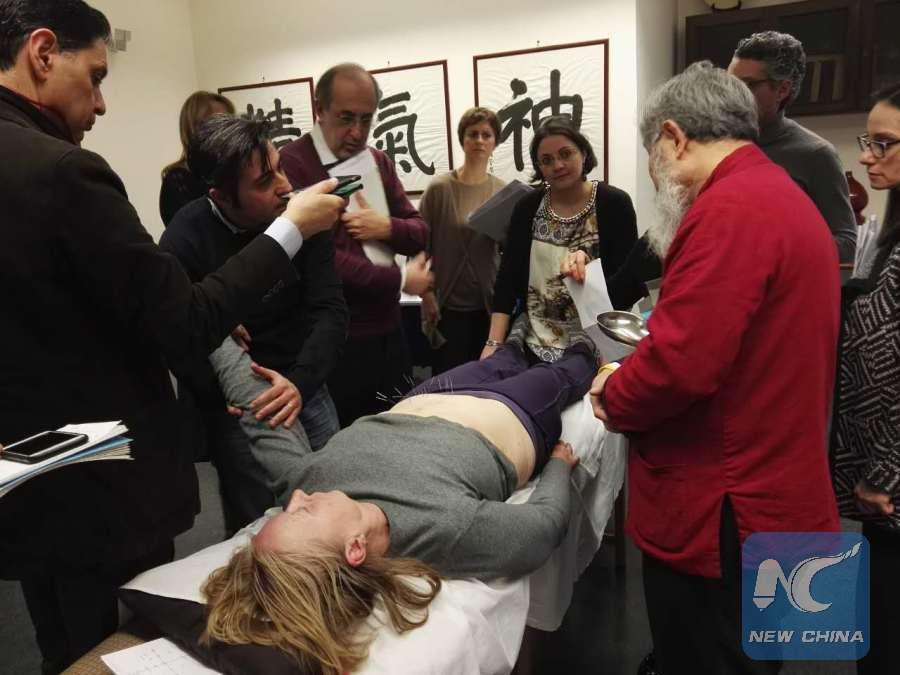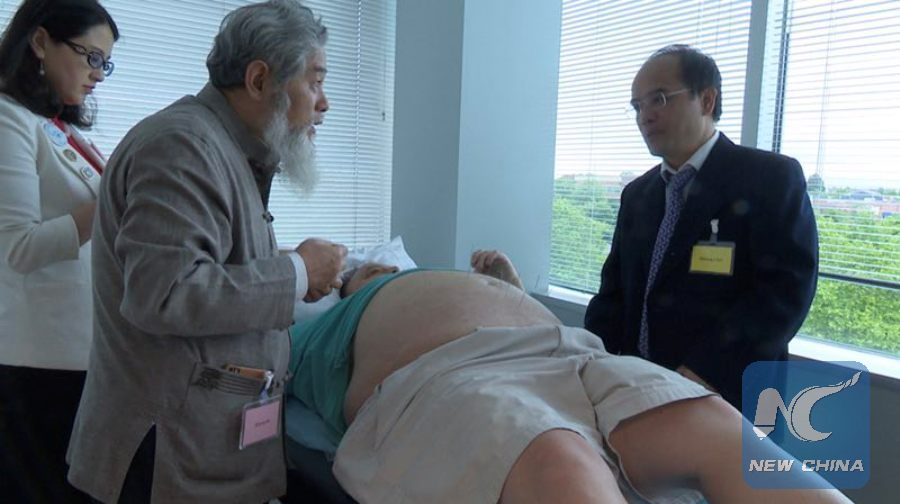
This file photo shows Bo Zhiyun (in red jacket), inventor of Abdominal Acupuncture, treats a patient in Italy. (Xinhua/Credit: Fan Hong)
by Xinhua writers Yuan Yue, Yang Shilong
NEW YORK, May 31 (Xinhua) -- Henry Pamboukian, a resident of Rockville in the U.S. state of Maryland, went to a local acupuncture workshop on a rainy afternoon. He had been suffering chronic pains in his back for three years and visited a range of physical therapists.
Having tried almost every treatment possibly, he then decided to take his wife's advice and give abdominal acupuncture a try.
As its name implies, abdominal acupuncture involves inserting needles on the patient's abdomen. A few minutes after the acupuncturist, 67-year-old Bo Zhiyun, inserted several 75-mm needles onto his belly,Pamboukian said the pain was gone.
"It's magic," Pamboukian said while still lying in bed. He said he didn't feel any pain at all though the needles were still on the his abdomen.
"The abdomen area is a hub where governor and conception vessels as well as the internal organs are all connected," Bo said. "That's why putting a needle there can treat the pain elsewhere."
The principles behind abdominal acupuncture treatment, or even acupuncture as a whole, cannot be fully explained with solid scientific proof and data at this stage, but traditional chinese medicine is growing in popularity in the United States along with other alternative therapies.
Clinics and practitioners of acupuncture are scattered and sought after in many parts of the country. Although acupuncture has been denounced by many scientists as nothing but a placebo, it has been proven effective by plenty of patients in relieving nausea and some other types of pains.

Bo Zhiyun, inventor of Abdominal Acupuncture, treats a patient on May 24, 2017 at the Beijing University of Chinese Medicine's U.S. research center in Rockville, the United States. (Xinhua/Yuan Yue)
A FLOURISHING ALTERNATIVE
For decades, TCM has been recognized as an alternative therapy in the United States. The treatment is included neither in the country's medical system, nor in the curricula of most of its medical schools. Yet demands for TCM, and acupuncture in particular, has been on the rise.
Only four states in America to date do not have legislation on professional practices of TCM. It has grown into an industry with 40 thousand licensed therapists, and treats over 380 million patients every year.
The world has rediscovered the value of TCM in recent years after the 2015 Nobel Prize in Psychology or Medicine was awarded to Tu Youyou, a Chinese pharmacist whose discovery and extraction of artemisinin in the treatment of malaria won her world fame.
Although the Nobel Prize did not honor TCM in particular, the fact that the findings are based on a Chinese medical context and proven to be effective through TCM clinical experiments is indisputable.
Acupuncture has also been studied alongside conventional western treatment in some recent research.
Virender Rehan, a professor specializing in pediatrics at the University of California, Los Angeles, has been studying the effective of acupuncture in mitigating the damage to newly born babies whose mothers has been exposed to nicotine during pregnancy. The babies might otherwise be born with pre-existing lung malfunctions
The result, he said, was that active acupuncture intervention to pregnant women was an effective strategy to prevent such damage throughout the antenatal, natal and postnatal periods.
"Our studies are showing that we can address the fundamental mechanism of the disease process through acupuncture or some other Chinese medicine approaches," Rehan told Xinhua.
"By applying Chinese medicine with western medicine, we are combining a holistic approach," he added.

Bo Zhiyun, inventor of Abdominal Acupuncture, speaks in an office of Xinhua News Agency North America in New York, the United States on May 31, 2017. (Xinhua/Wang Ying)
UNLOCKING WISDOM OF CHINESE CULTURE
As Chinese therapists conduct treatments all across the United States, some American institutions are offering degrees and giving accreditation to TCM practitioners as well.
Five Branches University, a private university in California, is one of those educational institutions. It was established in 1984 by Ron Zaidman, who has been president of the university ever since.
At present, the university has over 100 academic staff members, offers curricula including acupuncture, herbology, tui-na massage, energetics and dietary medicine, and has trained many acupuncturists during its over 30 years of history.
"Like everything in life, it is a learning curve," Zaidman said, adding that many Americans are getting to know this ancient oriental treatment.
The fundamental idea behind TCM is about nature -- the nature surrounding human beings and the nature humans can master.
Zaidman said the holistic approach of TCM and the anatomic approach applied in medical treatments in the west reflect different world views of the two cultures, which he said are both valid in their own ways.
While the gap between TCM and the Western world is narrowing, work remains to be done before such ancient eastern practices become commonplace in countries like the United States.
"In the beginning, it may sound new or different," said Zaidman. "As you learn more and more about it, you understand the logic of it."

